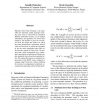293 search results - page 21 / 59 » Joint Morphological-Lexical Language Modeling for Machine Tr... |
ACL
2010
13 years 6 months ago
2010
We address the problem of selecting nondomain-specific language model training data to build auxiliary language models for use in tasks such as machine translation. Our approach i...
ACL
2007
13 years 10 months ago
2007
We present a novel method for predicting inflected word forms for generating morphologically rich languages in machine translation. We utilize a rich set of syntactic and morphol...
NAACL
2010
13 years 6 months ago
2010
Syntactic machine translation systems extract rules from bilingual, word-aligned, syntactically parsed text, but current systems for parsing and word alignment are at best cascade...
EMNLP
2010
13 years 6 months ago
2010
Minimum Error Rate Training is the algorithm for log-linear model parameter training most used in state-of-the-art Statistical Machine Translation systems. In its original formula...
LREC
2008
13 years 10 months ago
2008
In this paper, we present a simple yet efficient automatic system to translate biomedical terms. It mainly relies on a machine learning approach able to infer rewriting rules from...

